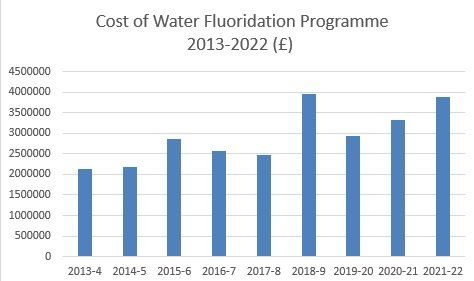Costs of Water Fluoridation in England (UK)
In 2017, UKFFFA published a technical report on Researchgate ( LINK ) relating to the cost of WF in England for the years between 2013-2017. The tables below update the technical report and take in the costs for f/y 2018 - 2021. Total costs include reimbursement by fluoridating local authorities to PHE for replacement fluoridation equipment. These capital costs seem to be recovered over several years to even out the expenditure. Regarding Bedford Borough Council, that Council no longer permits the fluoridation of the Borough's drinking water but in order to remove itself from this table, the Borough Council needs to go out to Public Consultation. This is allowed but the Council is dragging its feet although that's understandable at the moment due to Covid-19 slowing everything down.
Water Fluoridation Costs for 2020 - 2022
The entire topic of the cost of the UK's Water Fluoridation programme can be found as a technical report on Researchgate (LINK).
Costs have bee obtained by sending successive FoI requests of public Health England and the Office for Health Improvement and Disparities.
Costs for 2021-2022 are now available although we will have to wait until March 2023 for the breakdown into categories.

Analysis
Revenue costs have increased each year since 2013 apart from 2019-20 when the supplier changed to Israel Chemicals Ltd. Costs dropped but are now at the 2018-9 level.
Revenue costs include the cost of replacement fluoridation equipment. These costs are picked up by the fluoridating Local Authorities.
The cost of hexafluorosilicic acid each year for 10% of England stands at £1.6 million (2021 figures). This increased in 2021-2022 to £1.654 million.
A simple conversion of this figure for all of England is 1.6/10 x 100 = £16 million pa. Not a bad future profit for a hazardous industrial waste from the Negev Desert!
Capital costs of fluoridation equipment is a moveable feast. The least expensive seems to be £400,000 per Water Treatment Works whilst the equipment for Williamsgate Water Treatment Works in West Cumbria cost £1.6 million.
Elsewhere on this website, we have commented on the fact that 60% of the purchased hexafluorosilicic pours into sewage treatment works and half of that 60% ends up in rivers, streams and brooks on which Sewage Treatment Works are sited. Fluorides are "dangerous substances" in the aquatic environment (Directive 2006/11/EC retained) and must be controlled, so if the DHSC persists in rolling out the WF programme for England (and Wales?), its actions ought to have regard to the Directive. We await the Environment Risk Assessment promised by Earl Howe in the House of Lords in March 2022.
The DHSC has decided to foot the bill for ALL WF costs from 2022-2023 onwards, so it may not be possible to obtain a breakdown according to the expenditure for each Local Authority, although we should be able to provide a breakdown according to the type of cost.
Analysis of Costs from Fluoride Free Australia (FFA)
In this well-researched article, FFA explores the huge amount of public finance which is spent on purchasing the fluoridating acid.

